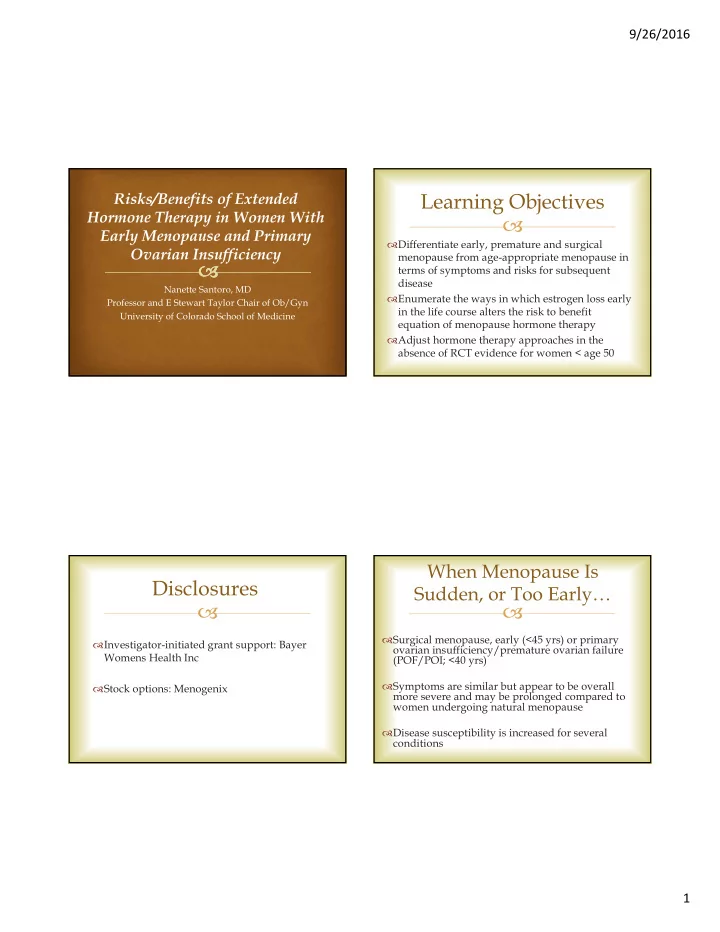

9/26/2016 Learning Objectives Differentiate early, premature and surgical menopause from age-appropriate menopause in terms of symptoms and risks for subsequent disease Nanette Santoro, MD Enumerate the ways in which estrogen loss early Professor and E Stewart Taylor Chair of Ob/Gyn in the life course alters the risk to benefit University of Colorado School of Medicine equation of menopause hormone therapy Adjust hormone therapy approaches in the absence of RCT evidence for women < age 50 When Menopause Is Disclosures Sudden, or Too Early… Surgical menopause, early (<45 yrs) or primary Investigator-initiated grant support: Bayer ovarian insufficiency/premature ovarian failure Womens Health Inc (POF/POI; <40 yrs) Symptoms are similar but appear to be overall Stock options: Menogenix more severe and may be prolonged compared to women undergoing natural menopause Disease susceptibility is increased for several conditions 1
9/26/2016 Premenopausal POF/POI: Symptoms May Oophorectomy or POF/POI Last For Many Years Many years of life without hormones Sample of 290 women from iPOFA website Worse menopausal symptoms Symptoms persist for decades in many Likely long-term consequence: bone resorption women Possible long-term consequences: ‘Usual symptoms*’ plus: Mortality (RR=1.5 [.97,2.34]), cancer (RR=2.34 [1.52, Brain fog, mood swings (>75%) 4.98]; Cooper) Hair loss, dry eyes, joint clicking (>50%) Adverse mood (Rocca) Only modest improvements in MenQOL Dementia (Rocca) sexual and physical domains over up to 4 Cardiovascular disease (RR=1.17 [1.02, 1.35]; Parker) decades after diagnosis *hot flashes, poor sleep, adverse mood, vaginal dryness Cooper, Am J Epi 1998; 8:229; Rocca, Mol Cell Endo 2014; Rocca, Neurodeg Dis 2012; 10:175; Parker WH, Ob/Gyn 2009; 113:1027 Allshouse, Menopause 2015; 22: 166 Early Menopause and Symptoms and Premenopausal Oophorectomy Health Risks Early withdrawal of estrogen Believed to be more severe Sleep Net reduction in breast cancer risk—fewer lifetime Mood (not all studies support risk; see Gibson vs years of estrogen exposure Schuster) Net increase in osteoporosis risk Hot flashes Net increase in CVD risk vaginal dryness Independent risk factor for failure to ever wean off of No known consequences to early withdrawal of hormones (Grady) progesterone Gibson, Ob/Gyn 2012; 119: 935; Schuster, Menopause Int 2008; 14:111; Grady, Ob/Gyn 2003; 102:1233 2
9/26/2016 How Does Menopause Populations at Risk for Early Affect CVD Risk? Heart Disease Renin-angiotensin-aldosterone system POF/POI (1-2%) upregulated in women after menopause Early menopause (<age 45; 5%) Salt sensitivity upregulated in women after Surgical menopause < age 65 menopause Atherogenicity of lipid profile increases with Elective risk reducing menopause; CIMT increases oophorectomy (any age) Endothelial function may be adversely affected by estrogen withdrawal Mass A Neth Heath J 2010; 18:598; El Khoudary Eur J Prev Cardiol 2016; 23: 694 Hypoestrogenemia Predicts CAD in Cardiovascular Mortality Increased Premenopausal Women After BSO Significant Predictors of CAD (logistic Oophorectomy HR mortality P value regression) Predictor OR 95% CI P Unilateral 0.82 (.67-.99) 0.04 Hypoestrogenemia* 7.4 1.7, 33.3 0.008 Bilateral 1.44 (1.01-2.05) 0.001 Aspirin Use in Past 7.6 1.7, 33.7 0.008 Reference 1 -- Week ATP-III 10 Yr Risk 8.3 1.2, 59.6 0.04 *defined as < 50 pg/ml Rivera CM, et al Menopause 2009; 16:15-23 Bairey Merz, J Am Coll Cardiol 2003; 41:413 3
9/26/2016 Some Statistics Newest Risk Pool Women with risk factors for ovarian carcinoma National Center for Health Statistics (2004): 617,000 Susceptibility genes estimated to be detectable in 10% of hysterectomies in the USA women who get ovarian cancer (1.4% lifetime risk) 73% of these entailed oophorectomy BrCA 52% are performed on women <44 years old Two relatives with the disease Breast cancer prior to age 45 Only 10% for cancer indications Other pedigree analysis 617,000 x .9 x .52 x .73= 210,792 women per year who More than 1/1000 women, numbers likely to increase over are surgically castrated at age 44 or earlier! time as genetic testing gets better 151,963,000 women x 0.14=21,274,820 additional premenopausal oophorectomies for cancer risk reduction! Premenopausal Premenopausal Oophorectomy: More Depression and Anxiety Oophorectomy Olmsted County Study: --Women interviewed by phone for 1,274 women with unilateral depression/anxiety (666 oophorectomy and oophorectomy 673 referent) 1,091 women with bilateral oophorectomy HR 1.54 (1.04-2.26) for depression 2,383 referent women age matched HR 2.29 (1.33-3.93) for anxiety All surgeries performed 1950-1987 --Estrogen treatment to age 50 did not modify risk Rocca WA, Menopause 2008; 15:1050 4
9/26/2016 Mortality Risk: Greater After Premenopausal Oophorectomy: Oophorectomy Up to Age 65 Worse Cognition Parker, et al: Survival advantage of 8.6% in women --Risks following oophorectomy greater for who had conservation of the ovaries up to age 65 Parkinsonism NO AGE GROUP showed a survival disadvantage with ovarian conservation Cognitive impairment Nurses Health Study: RR of mortality 1.12 (1.03, Dementia 1.21) with oophorectomy NO AGE GROUP showed a survival --Risks modified by estrogen treatment disadvantage with ovarian conservation Rocca WA, Neurodegen Dis 2008; 5:257 Parker, Ob/Gyn 2005; 106:219; and Ob/Gyn 2009; 113:1027 Attributable risks premenopausal Attributable Risks of Premenopausal oophorectomy Oophorectomy—Current Standard of Care Number at Disease Lifetime Relative Excess Cases risk* Prevalence Risk Number Disease Lifetime Relative Excess 21,485,612 CHD- 16.6% 1.44 1,569,309 mortality at risk Prevalence Risk Cases 21,485,612 Depression 10%-25 1.54 2,900,558 21,485,612 Anxiety 6.6% 2.29 1,829,285 210,792 CHD- 16.6% 1.44 15,396 mortality *assumes that all women who are candidates for risk 210,792 Depression 10%-25 1.54 28,454 reduction oophorectomies undergo the procedure. 210,792 Anxiety 6.6% 2.29 17,945 5
9/26/2016 Summary: Extended MHT for Women Summary: Premenopausal Oophorectomy With POF/POI and EM NO available data from RCTs to define long term use of MHT Clearly not a benign intervention in this population Should be performed for distinct clinical Extrapolation from clinical studies, clinical series and other indication (e.g., endometriosis, cancer risk available information favors the use of MHT in women with reduction) POF/POI and EM up to the age at ‘natural menopause’ (51.4 Estrogen ‘replacement’ may be insufficient to yrs) reverse all of the adverse outcomes After app age 50, risks and benefits should be individualized as they are for naturally menopausal women Many women do not adhere to estrogen Not all risks associated with POF/POI and EM may be treatment regimens reversed with MHT 6
Recommend
More recommend